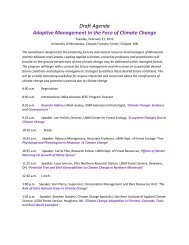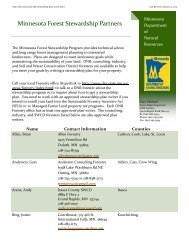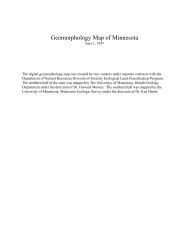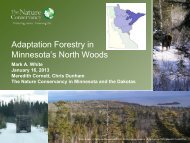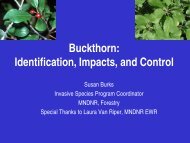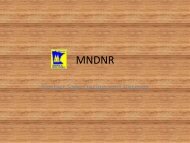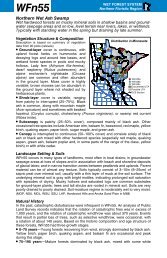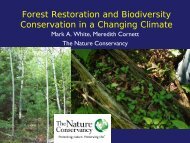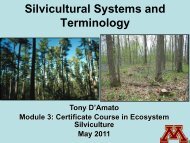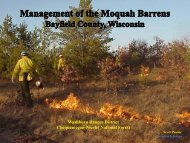Heterobasidion Root Disease
Heterobasidion Root Disease
Heterobasidion Root Disease
- No tags were found...
Create successful ePaper yourself
Turn your PDF publications into a flip-book with our unique Google optimized e-Paper software.
<strong>Heterobasidion</strong> <strong>Root</strong><br />
<strong>Disease</strong><br />
Managing to Prevent Pathogen<br />
Introduction<br />
Jennifer Juzwik<br />
NRS, U.S. Forest Service
<strong>Root</strong> <strong>Disease</strong>s: The Hidden Enemy<br />
Armillaria root disease<br />
(Armillaria ostoyae)<br />
Tomentosus root disease<br />
(Onnia tomentosa)<br />
Brown root and butt rot<br />
(Phaeolus schweinitzii)<br />
Ganoderma root and butt rot<br />
(Ganoderma applanatum)<br />
<strong>Heterobasidion</strong><br />
root disease<br />
(<strong>Heterobasidion</strong><br />
irregulare)
<strong>Heterobasidion</strong> root disease is one of the most<br />
economically important diseases of conifers in the north<br />
temperate zone.
Some <strong>Heterobasidion</strong> root disease basics<br />
• HRD is endemic on susceptible hosts in North<br />
America, Europe, and Asia,<br />
• Conifers are the major hosts,<br />
• HRD causes growth loss and mortality in<br />
Pinus species,<br />
• HRD is especially important where intensive<br />
thinning and monoculture are practiced,<br />
• HRD is very difficult to impossible to eradicate<br />
from a stand once the pathogen is<br />
established.
HRD has become a major concern in Wisconsin<br />
since the disease was first detected in 1993.<br />
First Detection<br />
Current Situation<br />
1993 – Adams Co.<br />
1994 – Iowa Co.<br />
23 counties with HRD<br />
Confirmed in > 50 stands
Why has HRD become such a problem in Wisconsin in less<br />
than 20 years<br />
<br />
<br />
Due to failure to detect or recognize the disease before 1993<br />
Was HRD possibly mis-diagnosed as red pocket mortality<br />
at times<br />
<br />
Has thinning in pine plantations without preventive<br />
treatment led to spread and intensification of HRD
What is the situation in Minnesota<br />
A fruiting body (conk) has<br />
been collected from<br />
Itasca State Park, but<br />
HRD has not been<br />
detected in the state<br />
Potential exists for natural<br />
spread of pathogen spores<br />
from western Wisconsin to<br />
pine stands on MN-WI<br />
border.
<strong>Disease</strong> biology and pathogen<br />
spread
<strong>Heterobasidion</strong> annosum is a fungus with a species<br />
complex.<br />
Ha is comprised of intersterile biological species defined<br />
as intersterility groups (ISGs).<br />
--- Includes at least two distinct North American and three<br />
distinct Eurasian ISGs.<br />
Nomenclature of <strong>Heterobasidion</strong> annosum species complex<br />
Prior to 2010<br />
• <strong>Heterobasidion</strong> annosum<br />
– P ISG Pinus species<br />
– S ISG Abies and Tsuga<br />
2010 to present<br />
• <strong>Heterobasidion</strong> irregulare<br />
– eastern North America<br />
• H. occidentale – western<br />
North America
The pathogen primarily spreads by aerially<br />
dispersed spores and by root contact between<br />
adjacent trees.<br />
Aerially borne<br />
basidiospores<br />
Stump<br />
infection<br />
Direct root<br />
infection<br />
<strong>Root</strong> contact<br />
spread
Seasonal variation in spore dispersal has been<br />
documented for plantations in central Wisconsin.<br />
Spore-trapping<br />
Sept 2009 – Dec 2011<br />
• Asexual stage of fungus grew<br />
on plates exposed every month<br />
of the year.<br />
• Fungus colonies most<br />
abundant during late summer,<br />
fall and early winter.<br />
• Only a few colonies developed<br />
on plates exposed during<br />
January and February, but<br />
colonies did develop from plates<br />
exposed just below freezing.
Once established in a stand, H. irregulare spreads<br />
outwardly from infected stump to form disease<br />
centers (“circles of death”).<br />
Source: G. Stanosz, U. Wisc. - Madison
Susceptible coniferous hosts and other species that<br />
support fruiting body production<br />
• HRD common in red pine<br />
and white pine<br />
plantations in Wisconsin<br />
and jack pine plantations<br />
in Quebec.<br />
• The fungus also occurs<br />
on Picea glauca, Abies<br />
balsamea, and other<br />
conifers in Wisconsin.<br />
• Fruiting bodies found on<br />
hardwoods, shrubs &<br />
decaying wood.
Diagnosis of HRD requires some “detective” work.<br />
Site and tree symptoms<br />
• Thinning crown with<br />
fading foliage<br />
• Circular pattern or<br />
within row occurrence<br />
of symptomatic or dead<br />
trees<br />
Signs – fungus fruiting body<br />
On decayed stump<br />
At base of live tree<br />
Sampling and lab diagnosis<br />
• Excavate 2 main<br />
roots on opposite sides<br />
of suspect tree<br />
• Remove a 6 to 10<br />
inch segment of the root<br />
• Submit to diagnostic<br />
laboratory<br />
In forest floor litter<br />
“popcorn” like fruiting bodies
Approaches to disease management
Avoidance:<br />
Hazard rating systems are used in southeastern USA to guide<br />
foresters in rating planting sites for risk of HRD.<br />
Site factors and stand history<br />
conducive to root rot<br />
• Sand, loamy sand, and<br />
sandy loam soils at least 12<br />
inches deep<br />
o Good internal drainage<br />
o Low seasonal water<br />
table<br />
• Old agricultural lands<br />
HRD risk map for Georgia
Prevention:<br />
Treatment of stumps with borate product during thinning<br />
operations or clear felling is a key control tool.<br />
Granular<br />
product<br />
applied by<br />
sprinkling on<br />
stump surface<br />
Water soluble<br />
powder<br />
applied by<br />
spraying on<br />
stump surface
Application of liquid borate<br />
Dye added
Application of products<br />
Timing<br />
• During what season or<br />
what months should<br />
fresh stumps be<br />
treated<br />
Treatment during winter<br />
temperatures (20 to 32 F)<br />
requires addition of<br />
propylene glycol to liquid<br />
borate<br />
• How soon after felling<br />
should stump be<br />
treated
Eradication:<br />
Stump extraction has been tried in at least one northern<br />
location.
Guidelines for HRD management in northern states<br />
• WI DNR: Managing<br />
HRD<br />
– When scattered<br />
throughout stand<br />
– When rare in stand<br />
– When not in the stand<br />
See:www.dnr.state.wi.us/topic/<br />
ForestHealth/Annosum<br />
<strong>Root</strong>Rot.html<br />
NOTE:<br />
• A Revised Managers<br />
Handbook for Red Pine in<br />
the North Central Region<br />
(2006)<br />
o OUTDATED info on<br />
Annosum root disease<br />
National Forest Lands<br />
Approach (MI, MN, WI)<br />
• Consider proximity of<br />
stand to known HRD<br />
stand<br />
• Consider management<br />
situation<br />
• Advised mitigation<br />
strategy – based on<br />
response to above<br />
Contact: Linda Haugen, NA S&PF, St. Paul<br />
lhaugen@fs.fed.us
What can you be doing about HRD now<br />
• Train marking, stand<br />
exam and inventory<br />
crews to recognize HRD<br />
and H. irregulare conks<br />
• Actively look for the<br />
disease<br />
– Conduct surveys<br />
– Examine trees in suspect<br />
mortality centers<br />
– Be aware of where nearest<br />
HRD is located from pine<br />
stands<br />
• Submit samples from<br />
“suspect” sites or report<br />
to a forest health<br />
specialist<br />
Source: FHP staff, NA S&PF, U.S. Forest Service<br />
Photo source: en.wikipedia.org
Acknowledgements<br />
Kyoko Scanlon<br />
Forest Pathologist<br />
Wisconsin DNR<br />
Dr. Glen Stanosz<br />
Forest Pathologist Prof.<br />
Univ. of Wisc. - Madison<br />
Linda Haugen<br />
Plant Pathologist<br />
NA S&PF, USFS
Questions and Discussion



